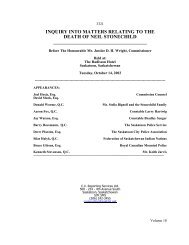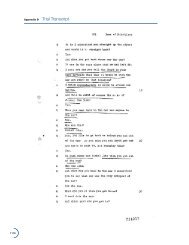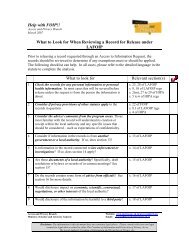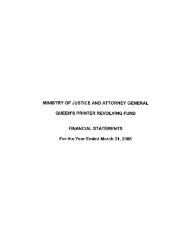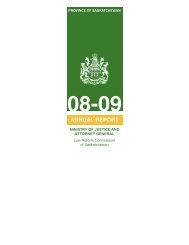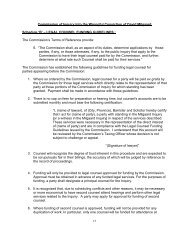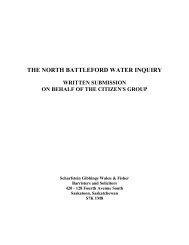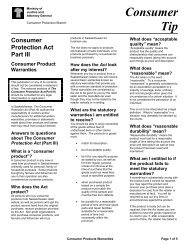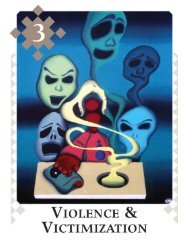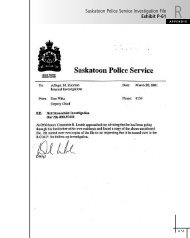Appendix K Memorandum of Law - s. 9(2) of the Canada Evidence Act
Appendix K Memorandum of Law - s. 9(2) of the Canada Evidence Act
Appendix K Memorandum of Law - s. 9(2) of the Canada Evidence Act
Create successful ePaper yourself
Turn your PDF publications into a flip-book with our unique Google optimized e-Paper software.
<strong>Appendix</strong> K <strong>Memorandum</strong> <strong>of</strong> <strong>Law</strong><br />
had given in <strong>the</strong> witness box? The decisions are conflicting: <strong>the</strong> weight <strong>of</strong> authority tends to establish <strong>the</strong><br />
negative, while <strong>the</strong> weight <strong>of</strong> reason and argument appears to us to be decidedly in favour <strong>of</strong> <strong>the</strong> affirmative.<br />
The Commissioners recommend ‘that a party should … be permitted not only as at present to contradict <strong>the</strong><br />
testimony <strong>of</strong> <strong>the</strong> witness by o<strong>the</strong>r evidence, but also to prove that such witness has made opposite statements.<br />
This recommendation became embodied in <strong>the</strong> UK remedial legislation <strong>of</strong> 1854 and was substantially adopted in<br />
<strong>the</strong> Canadian common law jurisdictions. The third branch exemplifies such legislation:<br />
But if <strong>the</strong> witness, in <strong>the</strong> opinion <strong>of</strong> <strong>the</strong> court, proves adverse, such party … by leave <strong>of</strong> <strong>the</strong> court, may prove<br />
that <strong>the</strong> witness made at o<strong>the</strong>r times a statement inconsistent with his present testimony; but before such<br />
last mention pro<strong>of</strong> can be given <strong>the</strong> circumstances <strong>of</strong> <strong>the</strong> supposed statement, sufficient to designate <strong>the</strong><br />
particular occasion, shall be mentioned to <strong>the</strong> witness, and he shall be asked whe<strong>the</strong>r or not he did make<br />
that statement.<br />
More than a century after <strong>the</strong> passage <strong>of</strong> Lord Denman’s <strong>Act</strong>, differences <strong>of</strong> opinion remain with respect<br />
to <strong>the</strong> correct construction <strong>of</strong> this branch <strong>of</strong> section 9. 12<br />
Sopinka 13 makes <strong>the</strong> following comment regarding <strong>the</strong> origins <strong>of</strong> s. 9(1) <strong>of</strong> <strong>the</strong> CEA:<br />
At common law, it was well established that one’s own witness could always be contradicted by o<strong>the</strong>r evidence,<br />
but not by general evidence <strong>of</strong> bad character. The cases conflicted however, as to whe<strong>the</strong>r or not a party had <strong>the</strong><br />
right to prove at trial that one’s own witness had made a prior inconsistent statement.<br />
In 1854, <strong>the</strong> English Parliament enacted section 22 <strong>of</strong> <strong>the</strong> Common <strong>Law</strong> Procedure <strong>Act</strong>. The wording <strong>of</strong> <strong>the</strong><br />
English act was reproduced in <strong>the</strong> <strong>Canada</strong> <strong>Evidence</strong> <strong>Act</strong> and all <strong>of</strong> <strong>the</strong> <strong>Evidence</strong> <strong>Act</strong>s <strong>of</strong> <strong>the</strong> Common <strong>Law</strong><br />
provinces contained similar provisions. 14<br />
Mewett and Sank<strong>of</strong>f give <strong>the</strong> following reasons for <strong>the</strong> enactment <strong>of</strong> s. 9(1) <strong>of</strong> <strong>the</strong> CEA 15 :<br />
Where a witness had been declared to be hostile, it was fairly clear at common law that <strong>the</strong> party calling him or<br />
her had <strong>the</strong> right to cross-examination, but not <strong>the</strong> right to launch a general attack on <strong>the</strong> creditworthiness <strong>of</strong><br />
that witness, as we have just discussed. What was never clear, nor satisfactorily resolved, was whe<strong>the</strong>r that party<br />
also had <strong>the</strong> right to prove that that witness had previously made a statement that was inconsistent with his or<br />
her present testimony. If a party calls a witness, knowing before hand that <strong>the</strong> witness is unfavorably disposed<br />
towards him or her or has an unsavory reputation, <strong>the</strong>n that party must decide before hand whe<strong>the</strong>r or not to call<br />
that witness, knowing full well <strong>of</strong> <strong>the</strong> dangers. But where a witness has given that party every reason to believe<br />
that he or she will give favorable testimony and, relying upon that, <strong>the</strong> party does call <strong>the</strong> witness, this is <strong>the</strong> one<br />
case where that party has been taken completely by surprise and cannot be faulted for foreseeing <strong>the</strong> danger.<br />
As early as 1834, <strong>the</strong> judges had different opinions on <strong>the</strong> question, and in 1854, England enacted a provision<br />
for civil cases that such pro<strong>of</strong> could be made [<strong>the</strong> Common <strong>Law</strong> Procedure <strong>Act</strong>, 1854 (U.K.)]. This was followed<br />
in 1865 by a similar provision for criminal cases [<strong>the</strong> Criminal Procedure <strong>Act</strong>, 1865 (U.K.)]. Soon <strong>the</strong>reafter this<br />
English legislation was adopted in <strong>Canada</strong>, both federally and in <strong>the</strong> provinces. 16<br />
Canadian Criminal <strong>Evidence</strong> 17 describes <strong>the</strong> nuances <strong>of</strong> <strong>the</strong> debate regarding a party’s ability to<br />
cross‐examine his or her own witness on a prior inconsistent statement at common law:<br />
36:40310 Cross-Examination as to statement<br />
12 The Statutory Rule, supra note 11 at pp. 116 and 117.<br />
13 John Sopinka, Sydney N. Lederman and Alan W. Bryant, <strong>Law</strong> Of <strong>Evidence</strong> In <strong>Canada</strong>, 2nd ed. (Toronto:<br />
Butterworths, 1999) (“Sopinka”).<br />
14 Sopinka, supra note 13 at paras. 16.49 to 16.50.<br />
15 Alan W. Mewett and Peter J. Sank<strong>of</strong>f, Witnesses, looseleaf (Toronto: Carswell) (“Witnesses”) at 14-4 to 14-7.<br />
16 Witnesses, supra note 15 at para. 14.3.<br />
17 Peter K. McWilliams, Q.C., Canadian Criminal <strong>Evidence</strong>, 3rd ed., looseleaf (Toronto: <strong>Canada</strong> <strong>Law</strong> Book)<br />
(“McWilliams”).<br />
2578



